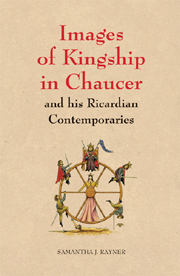Introduction
Published online by Cambridge University Press: 12 September 2012
Summary
… for within the hollow crown That rounds the mortal temples of a king Keeps Death his court, and there the antick sits, Scoffing his state and grinning at his pomp; Allowing him a breath, a little scene, To monarchize, be fear'd and kill with looks, Infusing him with self and vain conceit As if this flesh which walls about our life Were brass impregnable; and humour'd thus Comes at the last, and with a little pin Bores through his castle wall, and farewell king! Cover your heads, and mock not flesh and blood With solemn reverence: throw away respect, Tradition, form, and ceremonious duty, For you have but mistook me all this while: I live with bread like you, feel want, Taste grief, need friends: subjected thus How can you say to me I am a king?
Shakespeare, Richard II, III ii 161–77When John Burrow defined the poetry of the late fourteenth century as ‘Ricardian’, he linked it to the King in a way even he admitted was ‘not perfectly apt’. The period was an unstable one for England, as Richard II's rule took the country from one political crisis to another. The writers who lived through it reflect the shifting nature of their world in the range of styles they use and the attitudes they portray.
Though these styles are very different, the challenges that their works present actually allow for a more focused pursuit of specific themes. Studies in medieval literature, characterised at the beginning of the twentieth century by a mainly philological emphasis, have now become more historicist, with scholars pushing for more integration and co-operation with historians to show how interdependent literary and non-literary texts were during this period.
- Type
- Chapter
- Information
- Publisher: Boydell & BrewerPrint publication year: 2008



